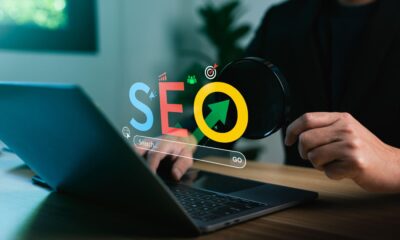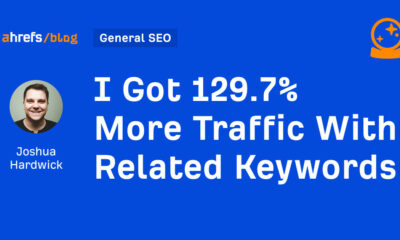MARKETING
When to Optimize and When to Pay for Traffic

If you’re struggling to get the word out about your brand new business venture, you’re not alone. Like you, many business owners struggle to acquire customers in the beginning.Balancing the cost, maintenance, and results of a marketing campaign isn’t easy. Most of the time, the solution to this problem is one of two marketing strategies: search engine optimization (SEO) or pay-per-click (PPC) campaigns. But which method is suitable for you?
In this article, we’ve explored what you can expect to achieve from each of these acquisition strategies. We’ve also provided some pros and cons of SEO and PPC strategies along with descriptive statistics and real-life examples to help you decide whether your business is best suited for SEO or PPC — or both.
What is SEO?
Search engine optimization is the process of enhancing your website’s visibility to make it rank and gain organic traffic from search engines.
Just as you turn to your favorite search engines, such as Google or Bing, to look up a new marketing acronym or where to get good pizza, so do your consumers. When you invest in SEO, you’re increasing the likelihood of your target audience finding you when they make a Google search for keywords related to your product or service. In fact, 61% of marketers say that SEO is a top inbound marketing factor for their business. But it’s easier said than done.
Here’s an example of SEO in action.
In the image below, Hubspot appears at the top of Google’s organic search engine results page (SERP) for the term “inbound marketing,” thanks to the SEO strategy we have in place.

The order of the results that appear on the search engine results page isn’t arbitrary. Each search engine takes into account several ranking factors that influence where a webpage gets placed. The goal of an SEO strategy is to create web pages and content that work with the ranking factors of the search engine in order to rise within the SERP rankings.
Are there other search engines besides Google?
Most SEO strategies center around Google instead of others like Bing and Yahoo! because it holds 92.47% of the search engine market share. Because of this, you’ll need to learn about Google’s 200 ranking factors, technical SEO, link building, content creation, and so much more if you want to appear higher up on the search engine results page.
Pros of SEO
Here are some advantages of SEO:
1. SEO is cheaper in the long run.
Although SEO might cost time and money —to pay freelancers or agencies, and for SEO tools — it’s still cheaper than PPC in the long run.
When you create content that ranks and drives traffic to your website, you no longer have to keep spending money to make your target customers see it. And when these customers decide to click on your link, it comes at zero cost, unlike a PPC campaign where you pay per click.
Organic traffic is also very scalable and cost-effective.
2. You can target different funnel stages with SEO.
Not all of your audience is at the same stage of the sales funnel.
Some are just getting to know your brand at the top of the funnel. And others are already at the bottom of the funnel, ready to pull out their wallets.
With SEO, you can create different content types (blog posts, guides, case studies) that meet each segment of your audience exactly where they are in the sales funnel. This gives your site a better shot at getting visitors to the next step in the funnel each time they browse your content.
3. Search traffic is more stable.
Once you rank on Google, you can begin to plan for and predict free traffic to your website as long as you keep optimizing it.
Another advantage to keep in mind is that there is no off-and-on switch with SEO. With PPC marketing, your website stops appearing on search results once your marketing budget dries up. A great way to remember this difference is by thinking in terms of real estate: SEO is like owning your traffic whereas PPC is like renting it.
4. Organic listings build brand authority.
Appearing consistently on search results for keywords related to your products and services helps build trust and brand authority with your target audience.
It also signifies to Google that you’re an expert on that topic or subject. This can lead to more backlinks from other trusted sites which is a ranking factor that search engines favor strongly.
Cons of SEO
Here are some reasons why you might not love SEO:
1. Search engine algorithms change.
Search engines, especially Google, have changed their algorithms many times over the years. These changes mean that you’ll have to keep a close eye on your marketing strategy and organic results.
2. You’ll need to optimize your website regularly.
Your job doesn’t end when you get your website to rank for target keywords for one month. Over time, you’ll have to regularly optimize your content and web pages so that your site continues to rank.
Optimization might include refreshing old articles and removing old/expired links.
3. SEO takes time to show results.
If your website or domain is new, it’s unlikely that you’ll enjoy immediate results from SEO. The reason is that several factors affect how Google ranks websites — many of which won’t be established within the first few weeks or months of launching your site.
2. It requires high-level skills and expertise.
If you’re not hiring a professional, make sure you understand your audience’s goals and meet them with quality content in order to optimize your site properly for the search engines.
It’s undoubtedly time-consuming and overwhelming to run a business while taking technical SEO, writing, and link-building classes, but it can be done if you commit to using an SEO strategy to generate revenue.
What is PPC?
PPC, or pay-per-click, is a form of search engine marketing (SEM) where an advertiser pays a publisher (such as Google or Facebook) for each click someone makes on an ad. This model allows businesses to pay only when consumers interact with their ads. If you use PPC ads, you’ll attract people who are interested in your offer and ready to convert.
You may have noticed that some of the top search results are tagged with an “Ad” marker, like the HelloFresh search results here. 
PPC ads always appear alongside organic search results. Some businesses run these search ads for specific marketing campaigns that have a definite start and end date. Others bid on their own brand name as part of their overall marketing strategy — like HelloFresh. Either way, this method is mainly associated with search engines as advertisers bid on keywords that are relevant to their target markets.
The cost of PPC ads usually depends on your industry and the search volume of the keyword you’re targeting.
PPC advertising can help your business stay competitive in a crowded market and quickly get in front of their target consumers if you don’t have the domain authority to get your site ranking organically on search engines.
Pros of PPC
1. PPC offers quick results.
While it can take months to see results from your SEO strategy, it can take just a few hours to see results from your PPC campaign.
2. PPC ads appear above organic rankings.
When you run a PPC campaign for your target keyword, your website would appear first on the search engine result page. This ranking makes your audience notice you first before scrolling to see other results.
3. PPC allows you to pinpoint your target audience.
While setting up a PPC campaign, you get to choose who you want to target with your ads.
Do you want people from a specific geographic area? Or people of a particular age? Marital status? Or interest? If so, then you should use PPC.
3. You can quickly run A/B tests on a PPC ad.
With a PPC campaign, you can run two different ads simultaneously to measure the one that converts better.
All you’ll have to do is change some ad elements like the ad copy and allow them to run for a period. Depending on the performance, you can decide to either “kill” the Google ads or continue optimization to improve your results.
Cons of PPC
1. PPC ads are expensive.
Without money, you cannot run a PPC campaign.
You have to pay for every link that your audience clicks, meaning once your budget dries up, so does your traffic.
Also, a PPC ad can get even more expensive (as high as $40) when you’re in a competitive industry like legal or insurance.
2. Lower profit margins.
While a PPC campaign might bring short-term wins, it’ll usually result in lower profit margins. Because PPC is a “pay to play” system, your customer acquisition costs (CAC) would continue to get higher without a significant increase in the prices of your products and services.
3. PPC ads become stale after a while.
You have limited control over your paid ad because of the rule set by ad platforms like Google. As such, your copy might have similar wording to your competitors, which makes it easy for your audience to pass over quickly.
SEO vs. PPC
Search engine optimization (SEO) can help your content rank high on search engines, making it more likely that your audience would click and trust your content.
SEO is also more effective for local searches and can grow your online presence for longer. Pay-per-click (PPC), on the other hand, is an acquisition strategy that requires you to spend ad money to get your content in front of an audience when they search for specific keywords online.
SEO vs. PPC: Which is better?
Asking which is better between SEO and PPC is like asking whether it’s better to eat with a fork or spoon — it depends.
Serving pasta? Sure, I’d love a fork. Soup? I’d rather have a spoon.
In the same way, different situations exist where SEO is better than PPC and vice versa.
Let’s now look at some of these situations.
Use SEO if…
- Your marketing budget is low.
- You want to build your brand authority.
- You’re looking to maximize your long-term return-on-investment (ROI).
- You want to create content that reaches your audience at different stages of the sales funnel.
Use PPC if…
You’d get better results with PPC in situations where:
- You want quick results.
- Your product is novel or first-of-its-kind.
- You’re promoting a time-sensitive offer, like a holiday sale.
- You want to direct your audience to a sales or landing page.
How to Make SEO and PPC Work For You
Instead of choosing between SEO or PPC, why not combine the two strategies and make them work for you?
Here’s how you can get the best of both worlds.
1. Create retargeting ads.

Did someone visit your site, probably the pricing or check-out page, without buying?
You can easily use a retargeting ad to prompt these visitors, even after they’ve left your site, to come back and make a purchase.
2. Promote website content with social media ads.

While you want your content to rank organically, you can give it a quick boost by promoting it on social media.
Not only do these kinds of ads help with content distribution, but they could potentially help you acquire essential backlinks that’d boost your rankings.
Also, it’s going to be a shame not to promote your latest blog post, guide, report, or case study after spending hours creating it.
3. Collect data From ads to improve your SEO strategy.
PPC campaigns grant you access to a lot of data — keyword search volumes, keywords your competitors are bidding for, highest converting calls-to-action, and so on.
Aimed with all of this data, you’d be able to create better SEO strategies with less effort.
SEO vs. PPC Statistics
SEO
- Google is responsible for over 92.47% of global web traffic.
- 90.63% of online content gets zero traffic from Google, with only 0.21% getting over 1000 visits per month.
- 35.18% of browser-based Google searches resulted in an organic link click in 2020.
- 99.2% of website pages have less than 100 backlinks.
- Google processes over 5.6 billion searches per day (or 2 trillion searches per year.)
- 64% of marketers actively invest in SEO.
PPC
Final Thoughts
Whether you choose to go with SEO or PPC ultimately depends on your business situation. So take your time to evaluate the pros and cons of both SEO and PPC to see which is the right fit for you. And if possible, integrate the two strategies to see even more outstanding results for your business.
Editor’s note: This post was originally published in July 2019 and has been updated for comprehensiveness.
Editor’s note: This post was originally published in July 2019 and has been updated for comprehensiveness.
Source link

















You must be logged in to post a comment Login